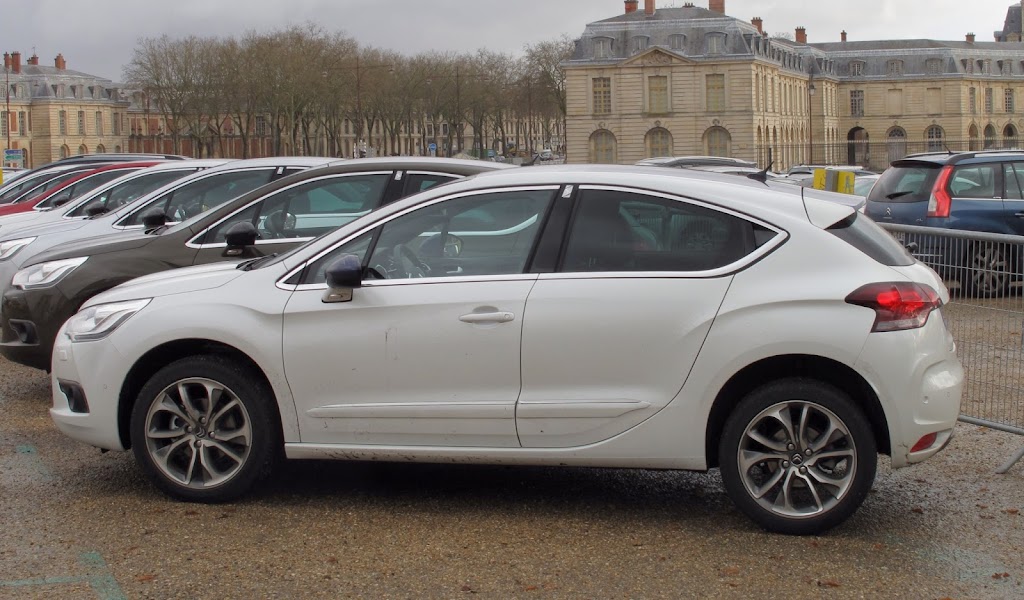Since the launch of the DS range some four years ago, the upmarket series of currently three cars has attracted around 500,000 sales, of which three in five were new customers to Citroen.
The French company has outlined plans to double the number of models in coming years, including an SUV which will initially be sold only in those aforementioned markets of China, Russia and Latin America.
DS — named after the iconic DS 19 of 1955 (above) which not only was the most streamlined and futuristic production car of its day, but also introduced advanced for the time technologies such as power disc brakes and hydraulic self-levelling suspension — will also differentiate its current cars from those on which they are based when the time comes to regenerate the models.
At the moment the DS 3 (above), DS 4 (below)
and DS 5 cars share components beyond platforms and engines with the more humble C3, C4 and — to a lesser extent — C5 from the Citroen brand itself.
At a briefing in Paris today to show new engines in the two smaller cars for 2015, the DS executives stressed that elements such as dashboard components will not be shared in future iterations, though platforms and powertrains will be common.
Prior to the Paris Motor Show in October, Citroen outlined its strategy for separate development paths for its products, with the Citroen brand concentrating on a more budget end of the market with cheerful, accessible and innovative cars such as the recently launched C4 Cactus. The DS tilt at the premium market will use more sophisticated styling, high quality and distinctive interiors, and offer a different customer experience. A concept shown at Paris hinted at the sophisticated design trends contemplated for DS.
In addition, the DS cars are to be strongly targeted towards residents of the 160 biggest and most developed cities in the world, those of us at the briefing heard. That's because some 70 percent of the world's developed populations are expected to be living in cities in the relatively near-term future.
The DS branding will also lose its overt Citroen connection in all markets. In China already, the familiar double chevron motif is no longer used on the DS cars, and company executives say this will also be the case in Europe fairly soon. The 100 dealerships already established in China are also stand-alone sales outlets for DS.
Although a timeline for the doubling of the model numbers in Europe is without doubt laid down in Citroen's boardroom, the executives of DS in Paris were coy about revealing it. They did say, however, that it is envisaged that all DS models sold in Europe will be built here. The Russia and South America markets will be fed from production in China.
The progress of DS in Europe is spotty enough so far. The most successful of the three models is the DS 3, largely on the back of sales in the UK where it is the biggest selling small diesel car there, and also tops the JD Power favourites. Overall, some 320,000 units of the DS 3 have been sold, almost two-thirds of the brand's production. In the related Citroen models, about one in three is a DS in Europe, while in Ireland it's more like one in 30.
The Paris event this week highlighted drives in DS 3 and DS 4 cars with new turbocharged petrol and diesel engines. Compared to their predecessors, the petrol engines particularly offer much more torque, power, and significantly better fuel consumption. The increased torque, over a much wider band, was very evident in driving outside and west of the French capital, with much less gearchanging required on twisting back roads.
There have also been tweaks to the exterior styling and some evident upgrades to the interiors. With customising a major part of sales strategy, the two-tone offer involving different colour roofs has been expanded. In some markets, the roof can be ordered with the buyer's favourite locality colours and motif (football team colours would seem to be a marketable option here?).
Special leather interiors are also available, and DS designers say that, for instance, it takes 15 hours to stitch together and install a leather dashboard for a DS 4.
DS people admit that it's not easy to launch and make acceptable a new premium brand. And they don't expect to achieve it in a short term. But it can be done, has been done, with Lexus and Audi just two examples of mass market carmakers establishing competitive prestige brands.
It remains to be seen if Gallic flair can repeat the exercise.



